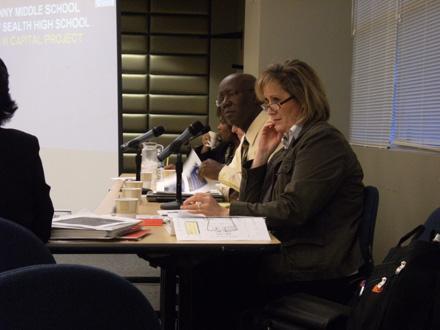Board ponders plan for Denny/Sealth
ROAR FOR 4 West Seattle High School Students march down California Avenue in support of a four period day.
<b>Photo Steve Shay</b>
Mon, 01/14/2008
The Seattle School Board decided last week it would mull other options to the co-location of Denny Middle School and Sealth High, including sticking with separate campuses, which would delay completion by two years and go supremely over budget.
Under the current plan, Denny would be demolished and rebuilt next to nearby Sealth. District staff and school administrators have pledged the schools would maintain their autonomy, while also sharing some facilities, such as a health clinic and cafeteria.
The two schools would keep separate principals and teaching staff.
The $125 million capital project was approved by voters a year ago as part of a $490 million bond. The voter's pamphlet stated the funds would create a combined campus, but now some are questioning whether the public input process was thorough enough.
Parents, students and some staff at Sealth have voiced their discomfort with combining the grade levels. Many are skeptical about the realities of keeping younger and older students apart.
During an evening work session, some board members seemed to share that uncertainty.
New board director Sherry Carr questioned district staff about what was actually presented to the public at community meetings before the bond vote.
Harium Martin-Morris said the plan seemed like a one-school model and suggested he could see why the public would be confused about the wording of the project.
Schedules for several capital projects have been pushed forward because of anticipated increases in the cost of construction. The Denny/Sealth project is supposed to break ground this summer, a year ahead of schedule, and that quick pace has likely left the community in doubt, said Michael DeBell.
"We're certain that they're uncertain about this project," he said.
He also warned fellow board members that going forward with a plan disliked by parents could lead to a change in enrollment patterns, possibly disrupting the recent academic gains both schools have made.
"One thing I would not want to see lost is the momentum these schools have right now," said DeBell. "It's the continued success of these academic programs that should be the highest priority."
West Seattle's former board director Irene Stewart first presented the idea for the shared campus during the school closure and consolidation process in 2006. Most outreach was focused on that effort, making it difficult to communicate information and collect public input about the bond projects, said Don Gilmore, the district's capital project manager.
Some Sealth staff members have said they're getting the short end of the deal. While Denny would get a brand new school, Sealth would receive a new boiler, electrical and heating systems, classroom upgrades and safety improvements.
District staff presented the School Board with a few other options to consider, but each came with a heftier price tag. For another estimated $5 million to $10 million the district could stick with the current plan and timeline, while also providing Sealth with a few more perks like a new sports medicine clinic and upgrades to the auditorium.
If the schools are kept separate, the project would be delayed two years and cost several million more, said Gilmore.
This would mean re-designing the Denny site for a cost of about $25 million. Denny would get a rebuild and basic improvements would be done at Sealth.
About $2 million has already been invested into the current plan, said Gilmore.
DeBell said he was more likely to favor adding to the budget because a complete redesign would be too much of a financial loss. He empathized with the Sealth community, who would have to move out of their building for two years, whereas Denny would stay put and then move into a brand new school.
"There's inequality in the sacrifices the two schools are asked to make," said DeBell.
Chief Academic Officer Carla Santorno told board members there are several academic benefits to a combined 6-12 campus.
Co-location helps create a smooth transition between middle and high school, a delicate shift for many students, she said. There are more opportunities for staff to create a comprehensive program among the grade levels.
"Anytime you have a strong aligned educational program you have a better opportunity for student gains," said Santorno. "There's lots of potentiality for this arrangement."
Superintendent Maria Goodloe-Johnson suggested the board move quickly on a decision because the longer they wait the bigger the loss in buying power. The process should include further outreach with the school communities to minimize the disruption of the academic programs, she said.
"That makes this project that much more critical," Goodloe-Johnson said.
Board President Cheryl Chow said she would discuss other options but suggested she was more willing to move forward with the current plan.
"I've been elected to make some decisions," Chow said. "I will not need 100 percent buy-in, because with human nature, that doesn't happen."
Rebekah Schilperoort may be reached at 783.1244 or rebekahs@robinsonnews.com


